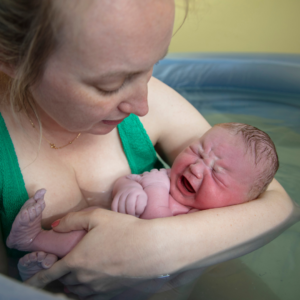What is Waterbirth, and How is it Different than Water Immersion in Labor?
With water immersion in labor, you get into a tub or pool of warm water during the first stage of labor, before your baby is born. In a waterbirth, you remain in the water during the pushing phase and actual birth of the baby The baby is then brought to the surface of the water after birth. With a waterbirth, the third stage of labor (when the placenta is born) may take place in or out of the water.
Waterbirth was first reported in an 1805 medical journal and became more popular in  the 1980s and 1990s.
the 1980s and 1990s.
I’d like to provide you with the evidence on the safety and health outcomes of waterbirth. Then, I will share an overall summary of the pros and cons of waterbirth.
Before we dive into the evidence on waterbirth, it’s important to understand the impact that laboring in water—regardless of whether you give birth in the water—has on the labor process.
For example, one review of seven randomized trials with 2,615 participants looked at water immersion during labor (before normal land birth) and found that laboring in water posed no extra risks to birthing person or baby (Shaw-Battista, 2017). Water labor helped relieve pain, (leading to less use of pain medication), and led to lower anxiety, better fetal positioning in the pelvis, less use of medications to speed up labor, and higher satisfaction with privacy and the ability to move around.
By the very nature of waterbirth, a birthing person who births in water must also labor in water (for at least a few minutes, but sometimes for hours) prior to the actual waterbirth. Therefore, it is not possible to completely untangle the benefits of water immersion in labor from those of waterbirth. So, with this in mind let us now review what research has demonstrated about waterbirth outcomes.
Overview of Evidence on Waterbirth
The truth is that researchers from all around the world had been studying waterbirth for decades—and most of the research had found (and continues to find) that with low-risk births, the benefits of waterbirth greatly outweigh the risks.
Waterbirth research includes:
- Randomized, controlled trials—participants are randomly assigned (like flipping a coin) to give birth in water or give birth on land, and their outcomes are compared.
- Observational studies—researchers enroll people in the study, measure if they have a waterbirth or not, and compare health outcomes. These studies can be prospective (meaning people were enrolled in the study before they gave birth and followed forward in time) or retrospective (meaning researchers look back in time at births that already happened).
- Meta-analyses and systematic reviews—researchers combine data from many randomized trials and/or observational studies to look for overarching trends.
- Qualitative research—researchers use patient interviews or written text to describe what it feels like to have a waterbirth.
- Case studies—each case study contains a report of a single bad outcome (usually a very rare outcome).
Randomized Controlled Trials on Waterbirth
There have been five randomized trials on waterbirth, and so far, they show that waterbirth benefits include:
- Lower pain scores.
- Less use of pain medication during labor.
- Less use of artificial oxytocin (also known as Pitocin®).
- Shorter labors on average.
- Higher rate of normal vaginal birth (birth without the use of forceps, vacuum, or surgery).
- Higher rate of intact perineum (meaning the tissue between the vagina and rectum remains untorn and uncut).
- Less use of episiotomy (a surgical cut to the perineum).
- Greater satisfaction with the birth.
One trial study, 60 people were randomly assigned to waterbirth and 60 people to land birth. There was no water labor—participants assigned to waterbirth entered the pool at the start of the pushing phase. The researchers found that the waterbirth group was more satisfied with their birth experience (78% vs. 58%), and that more people who had waterbirths said the pain was less than they expected it to be (57% vs. 28%). They found no difference in overall trauma to the birth canal between groups. The researchers defined trauma to the birth canal as labial tears, perineal tears, or injury to the vaginal wall.
Another Trial that showed Waterbirth Benefits:
The researchers assigned 53 people to waterbirth and 53 people to land birth. Everyone in the waterbirth group gave birth in water. The researchers did not find any differences in newborn outcomes, but they found quite a few differences in maternal health outcomes between groups.
Waterbirth led to:
- A higher rate of normal vaginal birth (100% vs. 79.2%)
- A shorter active phase of labor (114 minutes vs. 186 minutes)
- A shorter third stage of labor (6 minutes vs. 7.3 minutes)
- Less use of artificial oxytocin (0% vs. 94.3%)
- Less use of any pain medications (3.8% vs. 100%)
- A 23% lower rate of episiotomy
- A 12% higher rate of perineal tears (reporting that most were mild tears)
There were no differences between groups in the length of the pushing phase of labor or the rate of breastfeeding.
Largest Randomized Trial so far with 200 Participants
A 2013 trial randomly assigned 100 people to waterbirth and 100 people to land birth, making it the largest randomized trial ever done on waterbirth. In the end, 83 people ended up staying in the waterbirth group and 88 people stayed in the land birth group.
The study found that birthing people randomly assigned to the waterbirth group (all of whom labored in water) had a lower chance of needing a Cesarean later in labor compared to the land birth group (5% versus 16%). Participants in the waterbirth group reported less pain than the land birth group, but the researchers did not give any details on how pain was measured.
There was less meconium (baby’s first stool) in the amniotic fluid with waterbirth (2% versus 24%) and fewer low Apgar scores with waterbirth compared to land birth. An Apgar score is a test of how well the baby is doing at birth. A low Apgar score means that the baby may require more medical assistance.
Another Randomized Trial found Benefits to Waterbirth
A study that randomly assigned 60 participants to waterbirth and 60 participants to land birth. Everyone who was randomly assigned to the waterbirth group gave birth in the water.
The researchers did not find any differences in newborn health outcomes between groups, but they found several maternal health benefits to waterbirth. Compared to the land birth group, the waterbirth group had a higher rate of intact perineum (25% vs. 8%). The waterbirth group also had a much lower rate of episiotomy (2% vs. 20%), and lower pain scores. The total length of labor was also shorter in the waterbirth group, by an average of 50 minutes. They did not find any difference in the amount of blood loss between groups.
What are the Limitations of these Randomized Trials?
Randomized, controlled trials are often considered to be the “gold standard” in research. But when studying an intervention like waterbirth, it can be very hard to carry out a large, randomized, controlled trial. Some birthing people feel very strongly about waterbirth and are not willing to be randomly assigned to waterbirth or land birth. Others may be assigned to have a waterbirth, but then must leave the tub early for some reason.
The largest, highest-quality, and most important review on waterbirth was published by Burns et al. in 2022. This review included 36 studies (25 of which examined waterbirths) from hospital and community birth settings from the year 2000 through 2021, resulting in 157,546 participants in the analysis.
The researchers found that laboring and/or giving birth in the water was associated with the following health results compared to no water immersion:
- Less use of Pitocin® to speed up labor.
- Less use of injectable opioids for pain management.
- Less use of epidurals.
- Reduced pain levels.
- Higher rates of intact perineum (positive outcome), but only in obstetric settings; in midwifery settings there were no differences between groups.
- Lower rates of episiotomy.
- Lower risk of postpartum hemorrhage.
- Lower rates of maternal infection.
- Higher rates of maternal satisfaction.
And there were no differences between the laboring and/or giving birth in water group vs. the standard care group with regard to:
- Rates of amniotomy (artificial breaking of the waters).
- Rates of Cesarean (but Cesarean rates were very low overall; average of 3.6%)
- Shoulder dystocia.
- Obstetric anal sphincter injury (3rd or 4th degree tears).
- Need for manual removal of the placenta.
- 5-minute APGAR scores.
- Need for newborn resuscitation.
- Transient fast breathing of the newborn.
- Newborn respiratory distress.
- Newborn death.
- Breastfeeding initiation.
There was a higher risk of the following with waterbirth:
- Cord avulsion (also known as snapping of the umbilical cord after birth).
Midwives choose to participate in the MANA Stats Project by enrolling clients earlier in pregnancy and collecting data on them all the way through their pregnancy and birth. This is a process called prospective logging, which protects against a type of bias called selection bias. Selection bias happens when the study staff hand pick who they want in each group, based on what they hope the study to show. Selection bias did not occur in this study, because midwives were not allowed to select clients with only good waterbirth outcomes.
The waterbirth group experienced the following positive outcomes:
- Lower rates of postpartum hemorrhage.
- Fewer postpartum transfers to the hospital.
- Fewer postpartum hospitalizations for birthing people.
- Lower rate of severe perineal tears (3rd or 4th degree tears).
- Fewer newborn transfers to the hospital.
- Fewer cases of newborn respiratory distress syndrome.
- Fewer newborn hospitalizations.
There was a lower rate of newborn death in the waterbirth group—0.28 deaths per 1,000 deliveries compared to 0.51 deaths per 1,000 deliveries in the land birth group.
The only negative effects seen with waterbirth were higher rates of umbilical cord avulsion or tearing (sometimes called an umbilical cord snap) (0.57% vs. 0.37%) and higher rates of postpartum uterine infections (0.31% vs. 0.25%). But neither of these resulted in higher hospitalization rates for birthing people or babies, and none of the cases of umbilical cord avulsion resulted in death.
There were no differences between waterbirth and land birth groups in the rate of NICU admissions in the first 6 weeks, or in rates of newborn infections.
Like other research, it was found that waterbirth did not appear to increase the risk of bad health outcomes for newborns. In fact, babies born in the water had better health outcomes than babies born on land. The group that fared the worst were those who intended to have waterbirths but left the pool before giving birth. This left the lowest-risk people in the waterbirth group, who had the best outcomes on average.
Since people who birth in water are usually doing well, they (and their newborns) are more likely to have better results. Another way to look at these research results that the U.S. midwives showed good judgment by assessing risk and getting people with complications out of the tub as needed.
I hope this provides you with information if you are considering a waterbirth. For more information and guidance on pregnancy, birth, labor and postpartum care, get in touch.





